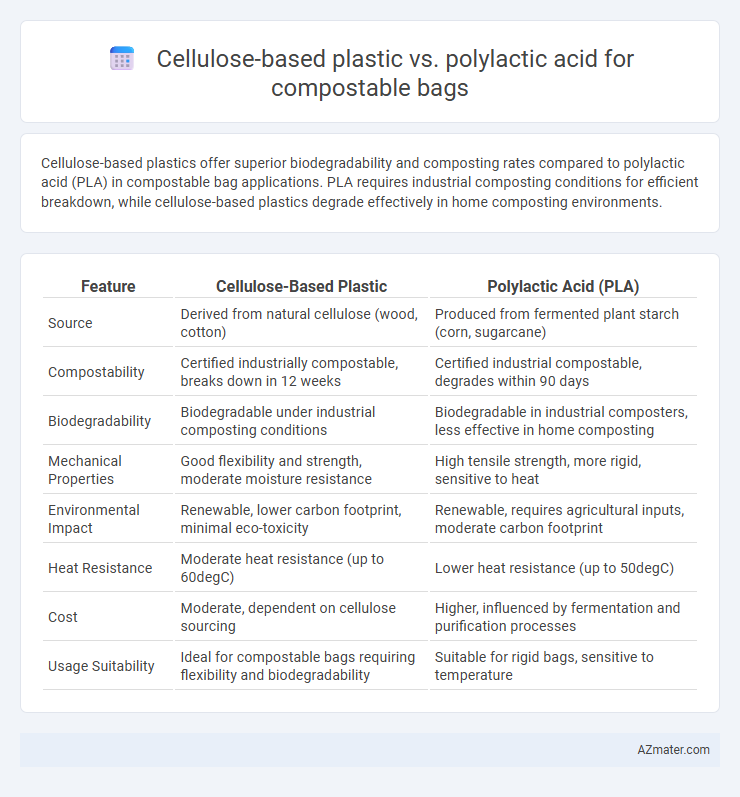Cellulose-based plastics offer superior biodegradability and composting rates compared to polylactic acid (PLA) in compostable bag applications. PLA requires industrial composting conditions for efficient breakdown, while cellulose-based plastics degrade effectively in home composting environments.
Table of Comparison
| Feature | Cellulose-Based Plastic | Polylactic Acid (PLA) |
|---|---|---|
| Source | Derived from natural cellulose (wood, cotton) | Produced from fermented plant starch (corn, sugarcane) |
| Compostability | Certified industrially compostable, breaks down in 12 weeks | Certified industrial compostable, degrades within 90 days |
| Biodegradability | Biodegradable under industrial composting conditions | Biodegradable in industrial composters, less effective in home composting |
| Mechanical Properties | Good flexibility and strength, moderate moisture resistance | High tensile strength, more rigid, sensitive to heat |
| Environmental Impact | Renewable, lower carbon footprint, minimal eco-toxicity | Renewable, requires agricultural inputs, moderate carbon footprint |
| Heat Resistance | Moderate heat resistance (up to 60degC) | Lower heat resistance (up to 50degC) |
| Cost | Moderate, dependent on cellulose sourcing | Higher, influenced by fermentation and purification processes |
| Usage Suitability | Ideal for compostable bags requiring flexibility and biodegradability | Suitable for rigid bags, sensitive to temperature |
Introduction to Compostable Bags
Compostable bags made from cellulose-based plastic and polylactic acid (PLA) offer eco-friendly alternatives to traditional plastics by breaking down under composting conditions. Cellulose-based plastics, derived from plant fibers such as wood pulp or cotton, decompose efficiently due to their natural polysaccharide polymers. Polylactic acid, sourced from fermented plant starch like corn or sugarcane, provides a biodegradable thermoplastic that converts into water, carbon dioxide, and organic matter in industrial composting facilities.
Overview of Cellulose-Based Plastics
Cellulose-based plastics are derived from natural polymers found in plant cell walls, offering excellent biodegradability and compostability for sustainable packaging solutions. These plastics exhibit superior moisture resistance and mechanical strength compared to polylactic acid (PLA), making them ideal for compostable bags requiring durability and environmental compatibility. The renewable origin and non-toxic decomposition of cellulose-based plastics contribute significantly to reducing plastic waste in composting systems.
Understanding Polylactic Acid (PLA) Plastics
Polylactic acid (PLA) plastics are derived from renewable resources such as corn starch or sugarcane, making them a sustainable alternative to traditional cellulose-based plastics for compostable bags. PLA offers superior clarity and strength, enhancing bag durability while maintaining biodegradability under industrial composting conditions. Understanding the thermal properties and composting requirements of PLA is crucial for optimizing its performance in eco-friendly packaging applications.
Raw Material Sources: Cellulose vs PLA
Cellulose-based plastic for compostable bags is primarily derived from renewable plant fibers such as wood pulp, cotton, or agricultural residues, offering abundant and sustainable raw material sources. Polylactic acid (PLA) is synthesized from fermented plant-based sugars, mainly sourced from corn starch, sugarcane, or cassava, which involves agricultural cultivation and processing. The choice between cellulose and PLA depends on factors including feedstock availability, land use impact, and renewable carbon content in raw materials.
Manufacturing Process Comparison
Cellulose-based plastics are derived from natural fibers extracted from wood pulp through chemical treatments that convert cellulose into bioplastic films, requiring processes like pulping, regeneration, and plasticization. Polylactic acid (PLA) is synthesized by fermenting sugar-rich biomass into lactic acid, followed by polymerization into PLA resin, involving steps such as fermentation, purification, and extrusion. Compared to the cellulose method, PLA manufacturing requires biotechnological fermentation and chemical polymerization, resulting in distinct processing energy demands and scalability factors for compostable bag production.
Degradation Rates in Composting Environments
Cellulose-based plastics exhibit faster degradation rates in composting environments, typically breaking down within 30 to 60 days due to their natural polysaccharide structure, which is readily consumed by microorganisms. Polylactic acid (PLA) requires higher temperatures and longer composting times, often 90 to 180 days, because it is a semi-synthetic polymer that needs industrial composting conditions to effectively hydrolyze. The choice between cellulose-based plastics and PLA for compostable bags depends significantly on the composting infrastructure available, as cellulose-based options are more compatible with home composting, while PLA is better suited for industrial facilities.
Environmental Impact Assessment
Cellulose-based plastics exhibit a lower carbon footprint due to their derivation from renewable plant fibers, enhancing biodegradability without releasing harmful microplastics during composting. Polylactic acid (PLA), sourced from fermented plant starches like corn, demonstrates efficient degradation under industrial composting but may persist in home composts, impacting environmental outcomes. Life cycle assessments reveal cellulose-based plastics generally outperform PLA in reducing greenhouse gas emissions and promoting soil health through complete mineralization.
Mechanical Properties and Performance
Cellulose-based plastics exhibit superior tensile strength and elongation at break compared to polylactic acid (PLA), enhancing durability and flexibility ideal for compostable bags. PLA tends to have higher stiffness and lower impact resistance, which may limit its performance under mechanical stress in packaging applications. Both materials biodegrade effectively, but cellulose-based plastics provide better mechanical resilience, making them suitable for heavier or more demanding compostable bag uses.
Cost and Commercial Availability
Cellulose-based plastics typically have higher production costs due to complex extraction and processing methods, resulting in limited commercial availability compared to polylactic acid (PLA). PLA benefits from established industrial-scale production, driven by widely available renewable resources like corn starch, making it more cost-effective and readily accessible for compostable bag manufacturing. Market adoption favors PLA for its better price-performance ratio and consistent supply chains in the biodegradable packaging industry.
Future Prospects and Industry Trends
Cellulose-based plastics show strong future prospects due to their biodegradability, compatibility with existing recycling systems, and sourcing from abundant natural fibers, aligning with increasing regulatory pressure on single-use plastics. Polylactic acid (PLA) continues to gain market traction because of its renewable feedstock base, versatility in compostable bag production, and advancements in industrial composting infrastructure enhancing its end-of-life performance. Industry trends indicate a growing preference for hybrid materials combining cellulose and PLA to optimize cost-efficiency, mechanical properties, and environmental benefits, driving innovation in sustainable packaging solutions.

Infographic: Cellulose-based plastic vs Polylactic acid for Compostable bag
 azmater.com
azmater.com